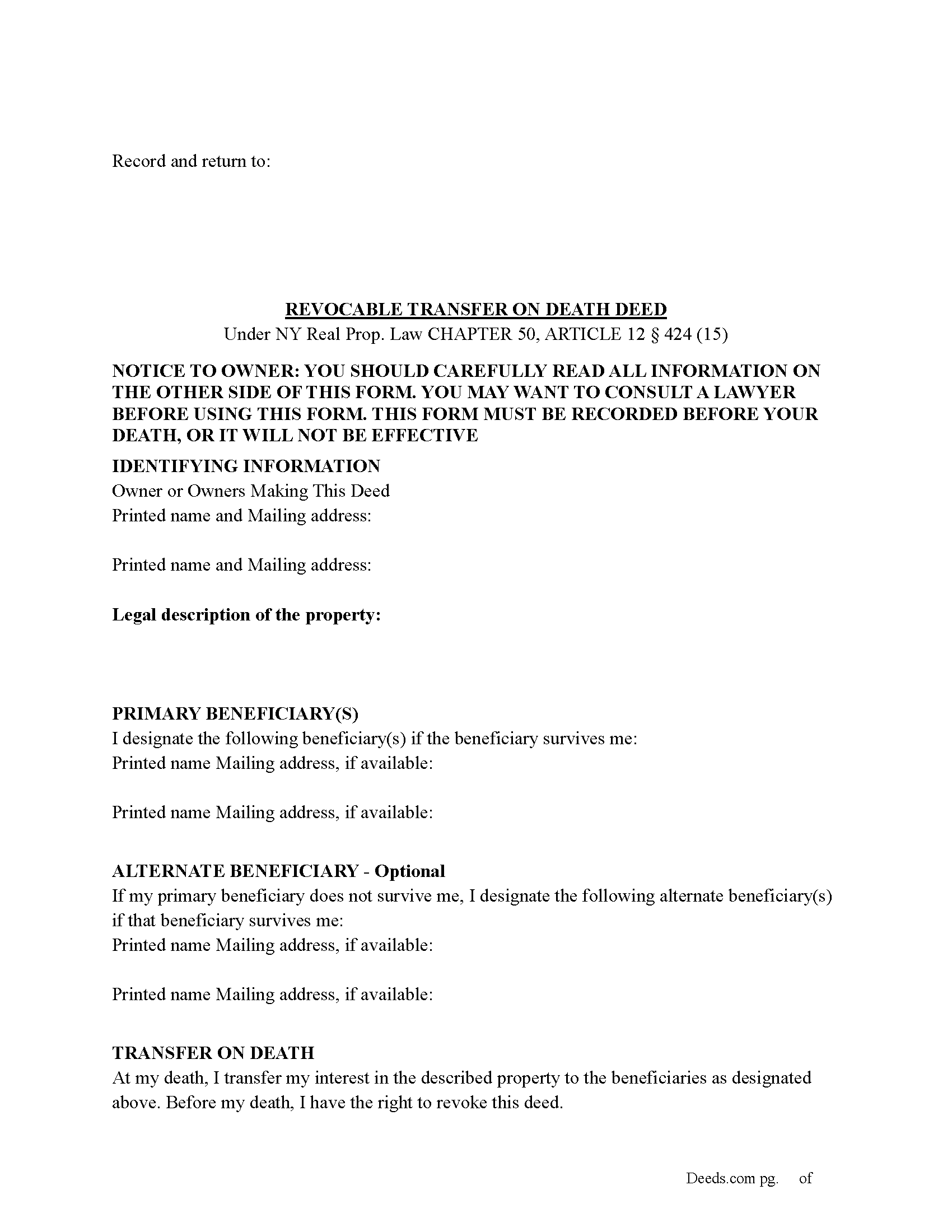New York Transfer on Death Deed
County Specific Legal Forms Validated as recently as December 1, 2025 by our Forms Development Team

About the New York Transfer on Death Deed

How to Use This Form
- Select your county from the list on the left
- Download the county-specific form
- Fill in the required information
- Have the document notarized if required
- Record with your county recorder's office
What Others Like You Are Saying
“Very fast and efficient. Easy to fill out but was upset the latest tax exemptions ruled in 2014 did …”
— Donald P.“Very Very helpful easy to navigate the guides and examples were great and informative. Great to have…”
— Sheryl C.“just what I needed...thanks”
— arturo b d.“I was very impressed with your site! My experience was excellent. Made my quest an easy one. Thank y…”
— Betty G.“It was great working with deeds.com. I needed to record quickclaim deed and the staff was very respo…”
— Sun H.
To use the Transfer on Death (TOD) Deed under New York’s Real Property Law (RPP) CHAPTER 50, ARTICLE 12 § 424 (effective July 19, 2024), follow these steps:
1. Complete the TOD Deed
Designate a beneficiary: Clearly name the individual or entity (such as a charity or trust) who will inherit your property upon your death.
Include contingent beneficiaries if desired (NOT required). These are backup beneficiaries who would inherit the property if your primary beneficiary cannot (e.g., if they predecease you). Ensure the deed is filled out correctly, including the legal description of the property.
2. Execute the TOD Deed: The TOD deed must be signed by the property owner (the transferor) in the presence of two witnesses and a Notary Public. The witnesses should not be the beneficiaries themselves, as this could raise legal issues.
3. Record the TOD Deed: The completed deed must be recorded with the County Clerk's office where the property is located during your lifetime. Recording the deed is crucial because, without it, the transfer will not be valid upon your death.
4. Retain Ownership During Lifetime: After recording the TOD deed, you retain full control of the property during your lifetime. You can still sell, mortgage, or revoke the TOD deed at any time.
If you change your mind, you can revoke the TOD deed by filing a revocation form or executing a new TOD deed, which automatically invalidates the previous one.
5. Upon Your Death: Upon your death, the property automatically transfers to the designated beneficiary without going through probate.
Key points about when it takes effect:
Timing of Transfer: The deed only takes effect upon the death of the property owner. Until then, the owner retains full control over the property and can revoke or change the TOD deed at any time.
Recording Requirement: For the TOD deed to be valid, it must be recorded with the county clerk during the property owner's lifetime. If the deed is not recorded before death, it will not be effective.
Probate Avoidance: By using a TOD deed, the property passes directly to the named beneficiary without going through probate, simplifying the transfer process and reducing legal costs.
Important: County-Specific Forms
Our transfer on death deed forms are specifically formatted for each county in New York.
After selecting your county, you'll receive forms that meet all local recording requirements, ensuring your documents will be accepted without delays or rejection fees.
How to Use This Form
- Select your county from the list above
- Download the county-specific form
- Fill in the required information
- Have the document notarized if required
- Record with your county recorder's office
What Others Like You Are Saying
“Very fast and efficient. Easy to fill out but was upset the latest tax exemptions ruled in 2014 did …”
— Donald P.“Very Very helpful easy to navigate the guides and examples were great and informative. Great to have…”
— Sheryl C.“just what I needed...thanks”
— arturo b d.“I was very impressed with your site! My experience was excellent. Made my quest an easy one. Thank y…”
— Betty G.“It was great working with deeds.com. I needed to record quickclaim deed and the staff was very respo…”
— Sun H.Common Uses for Transfer on Death Deed
- Transfer property between family members
- Add or remove names from property titles
- Transfer property into or out of trusts
- Correct errors in previously recorded deeds
- Gift property to others